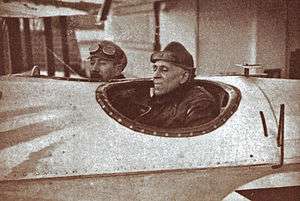First aerial crossing of the South Atlantic

The first aerial crossing of the South Atlantic was made by the Portuguese naval aviators Gago Coutinho and Sacadura Cabral in 1922, to mark the centennial of Brazil's independence. Coutinho and Cabral flew in stages from Lisbon, Portugal, to Rio de Janeiro, Brazil, using three different Fairey III biplanes, and covered a distance of 8,383 kilometres (5,209 mi) between March 30 and June 17.[1][2] Although the North Atlantic had already been traversed in a non-stop flight by John Alcock and Arthur Brown in 1919, Coutinho and Cabral's flight remains notable as a milestone in transatlantic aviation, and for its use of new technologies such as the artificial horizon.[2]
The journey

First aircraft
The journey started at the Bom Sucesso Naval Air Station in the Tagus, near the Belém Tower in Lisbon, at 16:30 on March 30, 1922, in the Portuguese Naval Aviation aircraft Lusitânia, a Fairey III-D MkII seaplane specifically outfitted for the journey.[1] The Lusitânia was equipped with an artificial horizon for aeronautical use, a revolutionary invention at the time;[1][2] according to the Portuguese Navy Museum, testing the horizon was one of the main reasons for the flight.
The first part of the journey ended on the same day at Las Palmas de Gran Canaria in the Canary Islands, where the aviators noticed that the plane's fuel consumption was higher than expected.[1] The journey resumed on April 5, when they departed for São Vicente Island, Cape Verde, traversing 1,370 kilometres (850 mi). After making repairs on the Lusitânia, they departed São Vicente on April 17 and flew to Praia on Santiago Island, and then to the Saint Peter and Saint Paul Archipelago, already in Brazilian waters, where they arrived on the same day, after flying 1,700 kilometres (1,100 mi) over the South Atlantic. They had reached that point by relying solely on the Coutinho's sextant with its artificial horizon.[1][2]
However, when ditching on the rough seas near the archipelago, the Lusitânia lost one of its floats and sank. The two aviators were saved by the cruiser NRP República, which had been sent by the Portuguese Navy to support the aerial crossing. The aviators were then carried to the Brazilian Fernando de Noronha islands.
Second aircraft

Enthusiastic Portuguese and Brazilian public opinion about the flight led the Portuguese government to send another Fairey III seaplane to complete the journey.[1] The new plane, baptized Pátria, arrived at Fernando Noronha on May 6. After being refitted, the Pátria departed on May 11 with Coutinho and Cabral on board. They flew to the Saint Peter and Saint Paul Archipelago to resume the journey at the point where had been interrupted. However, an engine problem forced them to once again make an emergency ditching in the middle of the ocean, where they drifted for nine hours until being saved by the nearby British cargo ship Paris City, which carried them back to Fernando Noronha.[1][2]
Third aircraft
A third Fairey III – baptized Santa Cruz by the wife of Epitácio Pessoa, the President of Brazil – was sent out, carried by the cruiser NRP Carvalho Araújo. On June 5, the Santa Cruz was put in the waters of Fernando Noronha and Coutinho and Cabral resumed their journey, flying to Recife, then to Salvador da Bahia, then to Vitória and from there to Rio de Janeiro, where they arrived on June 17, 1922, ditching in the Guanabara Bay. The two men were received as heroes by huge crowds, and were greeted by the aviation pioneer Alberto Santos-Dumont.[1][2] Although their journey had lasted 79 days, the actual flight time was just 62 hours and 26 minutes.
Later transatlantic flights
Coutinho and Cabral's aerial crossing inspired numerous subsequent transatlantic pilots, such as the American Charles Lindbergh, the Brazilian João Ribeiro de Barros and the Portuguese Sarmento de Beires, all of whom crossed the Atlantic in 1927.[1][2]
See also
References
- 1 2 3 4 5 6 7 8 9 CAMBESES JÚNIOR, Manuel, A Primeira Travessia Aérea do Atlântico Sul (PDF). Brasília: INCAER. 2008. Retrieved January 7, 2013.
- 1 2 3 4 5 6 7 PEREIRA, Armand F., Summary of the First Southern Atlantic Crossing (1922) by the Portuguese Aviators Gago COUTINHO and Sacadura CABRAL on a Fairey-17 Single Engine Hydroplane. HoneyMooney.com. Retrieved January 7, 2013.